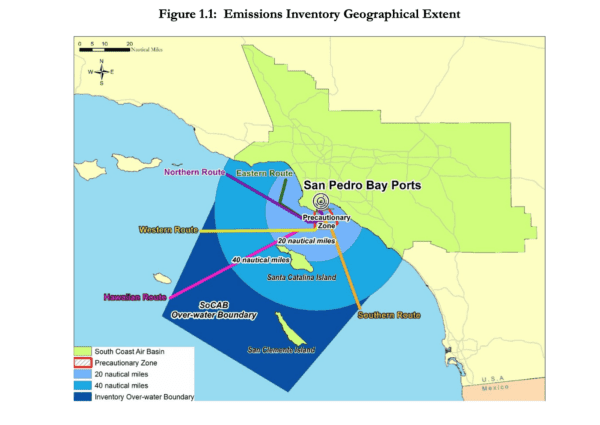 View Winners →
View Winners → Port of Los Angeles makes progress toward reducing emissions

The Port of Los Angeles made significant progress to reduce emissions in 2022 compared with its efforts in 2021, according to a report released Thursday.
The port’s Inventory of Air Emissions report showed emissions in 2022 were down from all-port related sources in part to a reduction of ships at anchor and ongoing environmental initiatives.
“The latest results are positive for our communities impacted by the port’s emissions,” LA Mayor Karen Bass said in a statement. “It is encouraging to see the port and its partners are back on track with reducing emissions associated with the movement of goods.”
Bass further remarked that there is “still work to be done” to achieve clean air goals.
The report showed that during 2022, emissions of diesel particulate matter, nitrogen oxides and sulfur oxides declined by 31%, 34% and 47% respectively, compared with the previous year. Emissions increased in 2021 due to the pandemic-induced cargo surge that strained the nation’s supply chain, according to the report.
The 2022 findings reflect the long-term progress the port has made in cutting diesel particulate matter, nitrogen oxides and sulfur oxides emissions, which are down by 88%, 63% and 97%, respectively, since 2005.
The latest data also showed the port remains ahead of its 2023 targets for reducing emissions.
“Regional, state and federal air regulatory agencies review these findings every year prior to their release,” Los Angeles Harbor Commission President Lucille Roybal-Allard said in a statement. “This process validates our progress and helps shape how we move forward to reach our ultimate goal of zero emissions.”
In addition, the annual report tracks yearly and long-term outcomes of port strategies for reducing pollution from ships, trucks, locomotives, harbor craft and cargo-handling equipment.
The 2022 data showed emissions from ships at anchorage fell 75% compared with 2021.
Due to the increase in vessel calls in 2021, ships at anchor became one of the most visible signs of record cargo volumes and supply chain disruptions that made that year an outlier.
Fewer ships delivering more cargo is among some measures helping to lower emissions. As a result of the larger vessels calling Thursday, container ship arrivals have dropped by 41% while container volume has grown by 32% since 2005, according to the report.
The port made progress in reducing greenhouse gasses, down 22% compared with 2021, and a 4% decrease since 2005.
Yet, cutting greenhouse gasses remains a challenge, port officials said. Progress hinges on further breakthroughs in operational efficiency, innovation and technology.
To reduce greenhouse gasses from ships, the port is collaborating with its trans-Pacific partners, including some of the world’s busiest ports in Asia, to decarbonize vessels and establish green shipping corridors.
The Port of Los Angeles continues to pursue strategies aimed at reducing emissions and greenhouse gasses by 40% below 1990s levels by 2030, and 80% below 1990s levels by 2050.
“While we have much work ahead, the year-over-year clean air gains show what we can do when we collaborate with our industry partners to tackle unprecedented challenges like reducing ships at anchor,” Port of Los Angeles Executive Director Gene Seroka said in a statement.
“At the same time, our longstanding initiatives such as the continued turnover of vessels, locomotives, drayage trucks and terminal equipment to newer, cleaner models and our dedicated pursuit of operational efficiencies continue to advance our march toward zero,” he added.
The port’s original goals and strategies were established in the 2006 San Pedro Bay Ports Clean Air Action Plan. The document’s 2010 and 2017 updates incorporate additional measures and targets for eliminating harmful air emissions from all port-related sources.







































































































